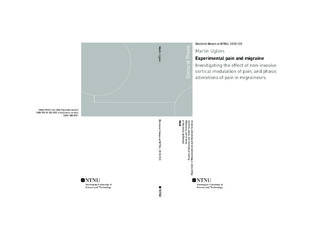| dc.contributor.advisor | Sand, Trond | |
| dc.contributor.advisor | Omland, Petter Moe | |
| dc.contributor.author | Uglem, Martin | |
| dc.date.accessioned | 2018-09-20T07:52:13Z | |
| dc.date.available | 2018-09-20T07:52:13Z | |
| dc.date.issued | 2018 | |
| dc.identifier.isbn | 978-82-326-3051-6 | |
| dc.identifier.issn | 1503-8181 | |
| dc.identifier.uri | http://hdl.handle.net/11250/2563549 | |
| dc.description.abstract | Background:
Both clinical symptoms, imaging findings, and neurophysiological measures suggest varying cyclic alterations in CNS-function between, before, during and after the migraine headache. Altered pain perception (preictal and ictal allodynia) seems to be a common non-obligatory clinical symptom in migraine. However, the pathophysiological mechanisms controlling this periodicity are still mostly unknown.
Quantitative sensory testing (QST), including pain thresholds and pain scores during tonic stimulation, and laser-evoked potentials (LEP) are useful measures of pain perception and processing. We explored how these measures change before, during and after migraine headache in a blinded longitudinal study.
Repetitive transcranial magnetic stimulation (rTMS) may alter the activity in stimulated and connected cortical areas. This method can help us understand the contribution of the stimulated cortical regions in migraine pathophysiology. We measured the effect of rTMS to the secondary somatosensory cortex (S2), a cortical area important for pain processing.
The main aim of the studies was to investigate changes in experimental pain measures in migraineurs, both between homeostatic states, here defined by migraine phase, and by external modulation of cortical excitability with rTMS.
Methods:
In the first study, we explored the effect of high-frequency navigated rTMS and sham stimulation to S2 on thermal detection and pain thresholds, and pain scores; comparing 26 migraineurs in the interictal phase with 31 controls.
In the second study, we measured both QST-measures and LEP four times in 49 migraineurs. The four sessions were categorized by migraine diaries and measures obtained between attacks were compared with recordings from the periods before, during and after an attack. Also, we compared interictal recordings with 30 controls. In both studies, the investigators were blinded during recording and analysis of the data.
Main results:
- RTMS to S2 increased cold and heat pain thresholds in controls compared to migraineurs in the interictal phase.
- Pain scores by prolonged heat stimulation of both forehead and hand decreased in the preictal phase.
- Trigeminal pain scores increased, and cold pain thresholds decreased (higher absolute temperature), during headache.
- There was a subtle lack of habituation of the N1 LEP-amplitude in the ictal phase.
Conclusions:
We found slightly altered central processing of pain in migraineurs. Effects were observed both as altered pain-modulation after cortical stimulation and by changes through the cyclic migraine-phase process. Interictal slight hyperalgesia, followed by short-lasting preictal hypoalgesia and ictal (and partly postictal) hyperalgesia was generally observed. The increased trigeminal pain sensitivity during headache complies with clinical symptoms and previous neurophysiological findings. However, since interictal and preictal alterations were observed for pain elicited from both hand and face, a general alteration in pain processing like central sensitization (as opposed to a regional trigeminal affection), is supported.
The lack of an analgesic effect by navigated rTMS may reflect non-optimal target, increased thalamocortical activation or decreased intracortical inhibition, and/or reduced activity of the descending pain modulation system in migraineurs.
The preictal hypoalgesia may be caused by transient thalamocortical hypoactivity, cortical hypoexcitability or excessive intracortical inhibition, or by increased endogenous analgesia. The wellknown autonomic symptoms before and during migraine, combined with the presently observed hypoalgesia, suggest a possible increase in hypothalamic cyclic modulation of both autonomic control and pain processing.
Although there were few significant results, with moderate effect sizes, our findings highlight the preictal phase as a promising focus in further studies. | nb_NO |
| dc.language.iso | eng | nb_NO |
| dc.publisher | NTNU | nb_NO |
| dc.relation.ispartofseries | Doctoral theses at NTNU;2018:130 | |
| dc.relation.haspart | Paper 1: Uglem, Martin; Omland, Petter Moe; Engstrøm, Morten; Gravdahl, Gøril Bruvik; Linde, Mattias; Hagen, Knut; Sand, Trond. Non-invasive cortical modulation of experimental pain in migraine. Clinical Neurophysiology 2016 ;Volum 127.(6) s. 2362-2369 | nb_NO |
| dc.relation.haspart | Paper 2: Uglem, Martin; Omland, Petter Moe; Nilsen, Kristian Bernhard; Tronvik, Erling Andreas; Stovner, Lars Jacob; Hagen, Knut; Linde, Anders Mattias; Sand, Trond Halfdan. Does pain sensitivity change by migraine phase? A blinded longitudinal study. Cephalalgia 2017 ;Volum 37.(14) s. 1337-1349. Copyright ©2017 Cephalalgia. Reprinted by permission of SAGE Publications. http://doi.org/10.1177/0333102416679955 | nb_NO |
| dc.relation.haspart | Paper 3: Uglem, Martin; Omland, Petter Moe; Stjern, Marit; Gravdahl, Gøril Bruvik; Sand, Trond. Habituation of laser-evoked potentials by migraine phase: a blinded longitudinal study. The Journal of Headache and Pain 2017 ;Volum 18:100. s. 1-14 | nb_NO |
| dc.title | Experimental pain and migraine: Investigating the effect of non-invasive cortical modulation of pain, and phasic alterations of pain in migraineurs | nb_NO |
| dc.type | Doctoral thesis | nb_NO |
| dc.subject.nsi | VDP::Medisinske Fag: 700::Klinisk medisinske fag: 750 | nb_NO |
